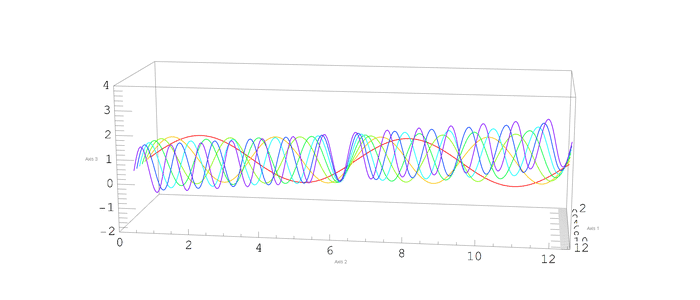Motivation
I'm trying to do a nice animation of the rotation of a ParametricPlot3D . My problem is that the Ticks numbers and AxesLabel text wiggle with an undesirable noisy component as the ViewPoint changes.
Questions
How can I figure out why it wiggles?
How do I avoid it?
I'm guessing that there is some "round up to nice values" going on somewhere, but the output of TracePrint its not too revealing to me.
Code
examplePlot = ParametricPlot3D[
Evaluate@Table[
{
k
, s
, Sin[k s] + k s/50
}
, {k, 7}
]
, {s, 0, 4 Pi}
, PlotRange -> {{-2, 4 Pi}, {0, 4 Pi}, {-2, 4}}
, BoxRatios -> {1, 3, 1}
, PlotStyle -> Array[Hue, 7, {0, 0.75}]
, PlotPoints -> 150
, MaxRecursion -> 5
, BaseStyle -> {FontSize -> 14, FontFamily -> "Helvetica",
FontTracking -> "Plain", TextJustification -> 0,
PrivateFontOptions -> {"OperatorSubstitution" -> False}}
, ImageSize -> {700, 300}
, ViewAngle -> 0.19
, Ticks -> {Range[7], Automatic, Automatic}
]
animExample = Table[
Show[
examplePlot
, ViewPoint -> {3, 0.4 + 0.5 Sin[j], 0.5 + 0.2 Cos[j]}
, RotationAction -> "Clip"
, ViewVertical -> {0, 0, 1}
, ViewAngle -> 0.22
, AxesEdge -> {{1, -1}, Automatic, {1, -1}}
, AxesLabel -> {"Axis 1", "Axis 2", "Axis 3"}
]
, {j, 0, 2 π, π/25}];
Export["animExample.GIF", animExample, "DisplayDurations" -> 0.15,
"AnimationRepetitions" -> Infinity]
Answer
Not a complete answer, but I think this can get you close to the solution.
If you use images instead of text, there's less (or even no) jumping around. I only worked on the ticks.
To have the ticks numbers rasterized, I made a variation of this, but there's probably a simpler way (I didn't try to put your ticks specification, but it should be easy).
Then, I played with the sizes and resolutions, and my end result still needs a lot of tuning: line thickness / darkness are a little lost in rasterings and resizings, numbers are flickering (but I do believe that they are not jumping; you tell me...)
I hope this helps as a start:
tickF[div1_, div2_: - 1] := (If[div2 == -1,
Thread[{#, #, {.02, 0}}, List, 2] &@FindDivisions[{#1, #2}, div1],
Join @@
MapAt[Join @@ # &, {Function[{p}, {p,
Magnify[Rasterize[p, RasterSize -> 150], 3], {.02,
0}}] /@ #[[1]],
Thread[{#, "", {.01, 0}}, List, 2] & /@ #[[2]]} &@
FindDivisions[{#1, #2}, {div1, div2}], {2}]]) &
examplePlot[j_] :=
ParametricPlot3D[
Evaluate@Table[{k, s, Sin[k s] + k s/50}, {k, 7}], {s, 0, 4 Pi},
PlotRange -> {{-2, 4 Pi}, {0, 4 Pi}, {-2, 4}},
BoxRatios -> {1, 3, 1}, PlotStyle -> Array[Hue, 7, {0, 0.75}],
PlotPoints -> 150, MaxRecursion -> 5,
BaseStyle -> {FontSize -> 14, FontFamily -> "Helvetica",
FontTracking -> "Plain",
TextJustification -> 0,
PrivateFontOptions -> {"OperatorSubstitution" -> False}},
ImageSize -> {3*700, 3*300},
Ticks ->
Evaluate@({(t1 = {##}; tickF[8, 5][##]) &, (t2 = {##};
tickF[8, 5][##]) &, (t3 = {##}; N /@ tickF[8, 5][##]) &}),
ViewPoint -> {3, 0.4 + 0.5 Sin[j], 0.5 + 0.2 Cos[j]},
RotationAction -> "Clip",
ViewVertical -> {0, 0, 1},
ViewAngle -> 0.22,
AxesEdge -> {{1, -1}, Automatic, {1, -1}},
AxesLabel -> {"Axis 1", "Axis 2", "Axis 3"}];
animExample =
Table[ImageResize[Rasterize[examplePlot[j], "Image"], 700], {j, 0, 2 \[Pi], \[Pi]/25}];
EDIT
Still based on rasterization, but better looking:
tickF[div1_,
div2_: - 1] := (If[div2 == -1,
Thread[{#, #, {.02, 0}}, List, 2] &@FindDivisions[{#1, #2}, div1],
Join @@
MapAt[Join @@ # &, {Function[{p}, {p, p, {.02, 0}}] /@ #[[1]],
Thread[{#, "", {.01, 0}}, List, 2] & /@ #[[2]]} &@
FindDivisions[{#1, #2}, {div1, div2}], {2}]]) &
examplePlot[j_, factor_] :=
ImageResize[
Rasterize[
ParametricPlot3D[
Evaluate@Table[{k, s, Sin[k s] + k s/50}, {k, 7}], {s, 0, 4 Pi},
PlotRange -> {{-2, 4 Pi}, {0, 4 Pi}, {-2, 4}},
BoxRatios -> {1, 3, 1},
PlotStyle -> Array[{Hue[#], Thickness[0.006]} &, 7, {0, 0.75}],
PlotPoints -> 150, MaxRecursion -> 5,
BaseStyle -> {FontSize -> factor*14, FontFamily -> "Helvetica",
FontTracking -> "Plain",
TextJustification -> 0,
PrivateFontOptions -> {"OperatorSubstitution" -> False}},
ImageSize -> {factor*700, factor*300},
ViewPoint -> {3, 0.4 + 0.5 Sin[j], 0.5 + 0.2 Cos[j]},
RotationAction -> "Clip",
ViewVertical -> {0, 0, 1},
ViewAngle -> 0.22,
AxesEdge -> {{1, -1}, Automatic, {1, -1}},
AxesLabel -> {"Axis 1", "Axis 2", "Axis 3"},
Ticks ->
Evaluate@({(t1 = {##}; tickF[8, 5][##]) &, (t2 = {##};
tickF[8, 5][##]) &, (t3 = {##}; N /@ tickF[8, 5][##]) &}),
BoxStyle -> Directive[Thickness[0.003]]
], "Image", RasterSize -> 4000], 700, Resampling -> "Linear"]
animExample6 = Table[examplePlot[j, 6], {j, 0, 2 \[Pi], \[Pi]/25}];
Export["animExample.GIF", animExample6,
"DisplayDurations" -> 0.15, "AnimationRepetitions" -> Infinity]
(not sure if factor is doing that much... but at least it is better looking, simpler and faster)



Comments
Post a Comment